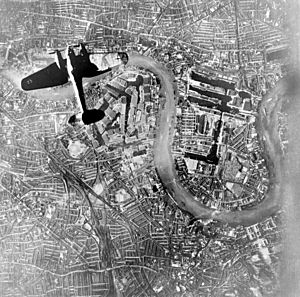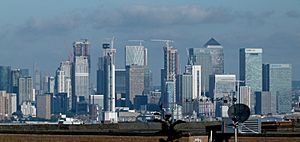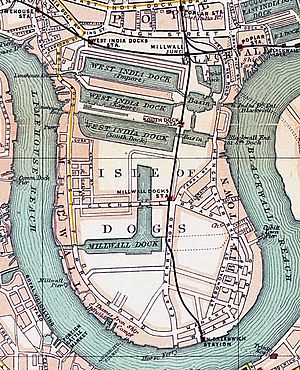London Docklands facts for kids


The London Docklands is an area along the River Thames in London, England. It used to be home to many busy docks. These docks were once part of the Port of London, which was one of the biggest ports in the world.
The Docklands are located in east and southeast London. They cover parts of several boroughs: Southwark, Tower Hamlets, Lewisham, Newham, and Greenwich.
After the docks closed down, the area became run-down by the 1980s. But then, a big project started to rebuild and improve the Docklands. Today, it's a modern area with many businesses and homes. The name "London Docklands" became popular in 1971 when a government report talked about plans to redevelop the area.
Contents
Building the London Docks
In ancient Roman times and the Middle Ages, ships arriving in the River Thames would usually stop at small docks in the City of London or Southwark. This area was called the Pool of London.
However, these early docks had problems. They didn't protect ships from bad weather. Also, they were easy targets for thieves, and there wasn't enough space for all the ships.
First Modern Docks
To solve these problems, the Howland Great Dock was built in Rotherhithe in 1696. This dock was much better. It was large, safe, and sheltered, with space for 120 big ships. It was a huge success and led to more docks being built.
During the Georgian and Victorian eras, many new docks were added. The first of these was the West India Dock, which opened in 1802.
More Docks Appear
Other important docks built around this time included:
- The London Dock (1805)
- The East India Dock (1805)
- The Surrey Docks (1807)
- The Regent's Canal Dock (1820)
- St Katharine Docks (1828)
- West India South (1829)
Later, more docks were built further east:
- The Royal Victoria Dock (1855)
- Millwall Dock (1868)
- Royal Albert Dock (1880)
- The King George V Dock (1921) was one of the last to be built.
How the Docks Worked
There were different types of docks. Wet docks were large areas of water where ships could stay safely while being loaded or unloaded. Dry docks were smaller and used for repairing individual ships. Dockyards were places along the river where ships were built.
The riverbanks were also lined with many warehouses, piers, and jetties. Each dock often specialized in different goods. For example, the Surrey Docks handled mostly timber, while Millwall Dock dealt with grain. St Katharine Docks handled wool, sugar, and rubber.
Dock Workers
The docks needed many workers. Some were lightermen, who moved goods between ships and the quays using small boats called lighters. Others were quayside workers who handled goods on land.
Some workers were very skilled, like the lightermen who had their own special guild. The deal porters, who carried timber, were known for their amazing acrobatic skills. However, most workers were unskilled and worked only when needed. They would gather each morning, often at pubs, and foremen would choose them for the day's work. This meant they never knew if they would have a job. This system lasted until 1965.
The areas where the docks were built were originally low-lying marshlands. Not many people lived there. As the docks grew, workers formed close communities with their own unique ways of life. Because it was hard to travel to other parts of London, these communities developed somewhat separately. For instance, the Isle of Dogs could only be reached by two swing bridges.
The 20th Century Docks
At first, different private companies owned and managed the docks. In 1909, the Port of London Authority (PLA) took over. They combined all the companies to make the docks more efficient. The PLA built the last dock, the King George V, in 1921. They also greatly expanded the Tilbury docks.

During World War II, German bombing caused a lot of damage to the docks. For example, 380,000 tons of timber were destroyed in the Surrey Docks in just one night. Even so, after the war, the docks were rebuilt and became busy again in the 1950s.
The End of the Docks
The docks closed very quickly between 1960 and 1970. This happened because the shipping industry started using a new system called containerization. This meant goods were packed into large metal boxes called containers. London's docks were not deep enough or big enough for the much larger ships needed to carry these containers.
So, shipping moved to deeper ports like Tilbury and Felixstowe. By 1980, all of London's docks were closed. This left about eight square miles (21 square kilometers) of empty, run-down land in East London.
Docklands Redevelopment
Plans to rebuild the Docklands started as soon as the docks closed. However, it took about ten years for these plans to really get going. The process was complicated because many different groups owned parts of the land.
To help with this, in 1981, the government created the London Docklands Development Corporation (LDDC). This group was in charge of buying and selling land in the Docklands and planning its development.
The government also made the area an "enterprise zone" in 1982. This meant businesses there didn't have to pay certain taxes and had other benefits. This made it much more appealing for companies to invest in the Docklands, which helped start a building boom.
The LDDC was sometimes criticized. Some people felt it focused too much on expensive luxury buildings instead of affordable homes. Local communities also felt their needs were not being met. However, the LDDC played a big part in changing the area. It closed down in 1998, and local councils took over.
Canary Wharf
The LDDC's big development program in the 1980s and 1990s turned a huge part of the Docklands into homes, offices, and light industry. The most famous part of this effort was the Canary Wharf project. This project built Britain's tallest building at the time and created a new business center in London.
Canary Wharf faced some challenges. A property downturn in the early 1990s stopped new building for several years. Developers found themselves with buildings they couldn't sell or rent for a while.
Transport Improvements
Historically, the Docklands had very poor transport links. The LDDC helped fix this by building the Docklands Light Railway (DLR). This new railway connected the Docklands to the city. It was quite cheap to build at first, costing only £77 million, because it used old railway lines and empty land.
The LDDC also built the Limehouse Link tunnel, a road tunnel that cost a lot of money. It connected the Isle of Dogs to a main road.
Another important development was London City Airport (IATA airport code LCY), which opened in 1987 in the Royal Docks.
The Jubilee line of the London Underground was extended east in 1999. It now serves areas like Canada Water, Canary Wharf, North Greenwich, and Canning Town. The DLR itself was also extended over the years, reaching places like Beckton, Lewisham, London City Airport, and Woolwich Arsenal.
Future Docklands Projects
More development is planned for the London Docklands area, including:
- Possible extensions of the DLR to Dagenham.
- Further development around Canada Water.
- New buildings at Blackwall Basin and Wood Wharf, near Canary Wharf.
- More skyscrapers at Canary Wharf, such as the Riverside South towers and the North Quay project.
In the 21st century, redevelopment is also spreading to other parts of east and southeast London, and into nearby areas of Kent and Essex along the Thames Estuary.
Docklands Buses
Some London Buses routes have numbers starting with 'D' for Docklands. These buses run on the north side of the River Thames and help people get to the DLR. The 'D' bus network was created when the Docklands were first being redeveloped. It used to be much larger, but as transport improved, fewer 'D' routes were needed. Today, only four 'D' routes remain.
The Docklands Today
The population of the Docklands has more than doubled in the last 30 years. The area has become a major business hub. Canary Wharf is now one of Europe's largest groups of skyscrapers and a big extension to London's financial district.
Most of the old wharfs and warehouses have been taken down. However, some have been restored and turned into apartments. Many of the docks themselves still exist and are now used as marinas or places for watersports. The Surrey Commercial Docks are a main exception, as they have mostly been filled in. While large ships can still visit the old docks sometimes, all commercial shipping has moved further downriver.
The success of the Docklands has also helped other nearby areas that were once run-down. Places like Greenwich and Deptford are now being redeveloped. This is mainly because better transport links make them more attractive for people who commute to work.
However, the redevelopment has also caused some issues. The huge increase in property prices has created tension between new residents and the older Docklands communities. Some long-time residents feel they are being pushed out. This has led to some very noticeable differences in wealth, with luxury apartments built right next to older public housing estates.
See also
 In Spanish: Docklands para niños
In Spanish: Docklands para niños





